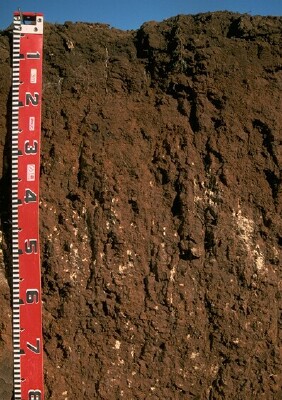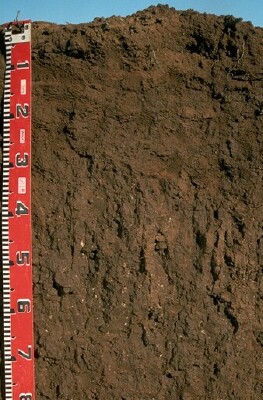LP68
| Group: Glenloth East Farm Advance Group | Australian Soil Classification: Endohypersodic, Pedal, Calcic CALCAROSOL |
| Northcote Factual Key: Dr 2.13 | Great Soil Group: red-brown earth |
| General Landscape Description: Higher level old alluvial plain. Original vegetation included Buloke (Casuarina leuhmanii), Grey Box (Eucalyptus microcarpa) and Yellow Gum (E. leucoxylon). This site is being used for legume trials. | |
Soil Profile Morphology
Surface Soil
| A1 | 0-10 cm | Dark reddish brown (5YR3/2); heavy clay loam (fine sandy); weakly structured; firm consistence moist; pH 7.4; abrupt change to: | |
| Subsoil | |||
| B21 | 10-35 cm | Dark reddish brown (5YR3/3); light medium clay; moderate coarse blocky structure; pH 8.3; clear change to: | |
| B22k | 35-80 cm | Reddish brown (5YR4/3); medium clay; moderate coarse prismatic, breaking down to very strong medium subangular blocky structure; strong consistence dry; contains a few (5-10%) soft carbonates and very few (1-2%) hard carbonates (in tubules); pH 9.1; gradual change to: | |
| B23 | 80+ cm | Reddish brown (5YR4/4); medium heavy clay; contains a few (5%) soft carbonates. | |
| Note: The soil varies across the pit. In some areas the B22 subsoil horizon is a slightly darker (5YR4/2) medium heavy clay with very strong medium blocky structure. It is also not as calcareous, with only very few (2%) hard nodules (up to 3-4 mm diameter). This horizon then grades into a dark reddish brown (5YR3/3) medium heavy clay at 80 cm. | |||
 Lp68 Profile A |  Lp68 Profile B |
Key Profile Features
- Alkaline throughout whole profile.
- Moderate texture contrast between surface soil and subsoil.
Key Profile Characteristics
pH | Salinity Rating | |||
Surface (A1 horizon) | slightly alkaline | very low | non-sodic | none1 |
Subsoil (B21 horizon) | moderately alkaline | low | non-sodic | none |
Deeper subsoil (at 80 cm) | very strongly alkaline | low-medium | strongly sodic | moderate - strong |
| 1 Moderate dispersion after remoulding. | ||||
 |
Management Considerations:
Wole Profile:
- Plant available water capacity (PAWC) is considered to be relatively moderate (estimated at approximately 125 mm) for this soil profile. This is based on available laboratory data and assumes an effective rooting depth of 80 cm. Effective rooting depth will be restricted by the deeper strongly sodic subsoil.
Surface (A) Horizons
- The surface soil is hardsetting and has a high fine sand content (41%). Upon wetting and drying the soil sets hard and will become "powdery" when worked. This makes the soil prone to wind erosion. Soils such as these depend on organic matter for maintaining surface structure. Improving soil organic matter levels will assist in improving aggregation which will improve structural problems such as surface sealing and hardsetting, as well as improving soil fertility and water holding capacity. Minimum tillage is practised at this site and should continue to be used. Stubble retention and utilising pasture rotations will also assist in improving organic matter levels.
- The surface horizons display a moderate amount of dispersion after remoulding. This indicates that excessive cultivation or overstocking of the soil in a wet condition may result in some structural degradation (e.g compaction, surface sealing) occurring. Also, unprotected surface soil may be prone to damage by raindrop action and surface sealing may develop. This will result in reduced water infiltration and seedling emergence. A cover of plants or stubble will assist in protecting the surface.
Subsoil (B) Horizons
- The subsoil from 35 cm depth becomes very strongly alkaline. This indicates that some nutrients (e.g. copper, iron, manganese and zinc) may be poorly available to plants.
- The deeper subsoil becomes strongly sodic from 80 cm and disperses. This will result in restricted root and water movement at depth.
Comments from Landholder
- Minimum tillage (direct drilling) practised.
- Safflower crop produced good yields.
- Waterlogging does not occur in this paddock.
- Gypsum has not been used (but has been applied to other paddocks with "hard red soils").
- Needs 30-40 points of rain before there is any benefit to plants.
- The moderately alkaline subsoil (becoming very strongly alkaline with depth) will reduce the potential to grow some crops (e.g. lupins).


